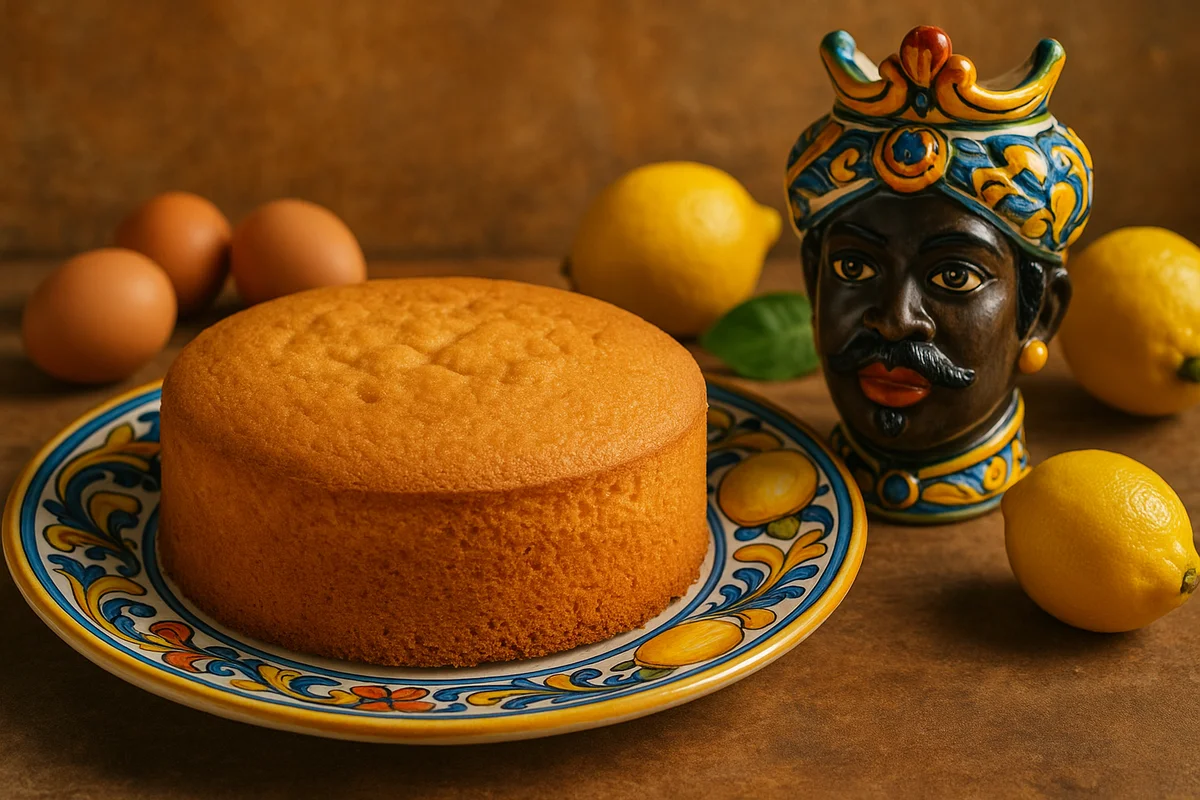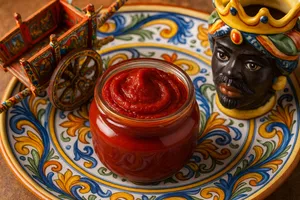Overview
Sponge cake is a fundamental preparation in classic pastry, consisting of a soft, springy mixture made with eggs, sugar and flour, without added fats (or with only minimal amounts). It is the quintessential base for filled cakes, spoon desserts, zuccotti, modern cassata cakes and countless other sweet creations. Its defining characteristic is its lightness, achieved through the incorporation of air into the whipped eggs, which during baking creates a delicate, aerated structure perfect for absorbing syrups and fillings.
In Sicily, sponge cake is used in modern and semi-traditional pastry to prepare cakes filled with creams, modern cassata (in place of the traditional shortcrust), bavarois, zuccotti and numerous other creations. Its preparation requires precise technique: the eggs must be perfectly whipped, the flour incorporated gently to avoid deflating the mixture, and the baking carefully calibrated to obtain a soft, moist result—never dry or rubbery. A well-made sponge cake is the foundation of many successful desserts, while a poorly executed one can compromise the entire preparation.
Basic ingredients
Classic sponge cake has three essential ingredients in precise proportions:
- Eggs: The principal ingredient. Whole eggs are generally used, though some variations call for only yolks or a combination. The eggs are whipped with the sugar until tripled in volume.
- Sugar: Usually in an amount equal to the weight of the eggs. Caster sugar is most common, though some prefer icing sugar for greater delicacy.
- Flour: Sifted 00 flour, in a quantity roughly half the weight of the eggs. Some add potato starch or cornflour (20–30% of the flour) for added lightness.
The classic base recipe is: 4 eggs (about 200g), 120–130g of sugar, 120–130g of flour. Optional: flavourings (vanilla, lemon or orange zest), a pinch of salt.
Traditional preparation
The preparation requires care and technique:
1. Whip the eggs: The eggs (whole or separated) are whipped with the sugar using an electric mixer or stand mixer, gradually increasing the speed, for 10–15 minutes. The mixture must triple in volume, becoming pale, foamy and “ribbon-like” (when lifting the whisk, the mixture falls in a ribbon that remains visible for a few seconds).
2. Incorporate the flour: The sifted flour is added in 2–3 additions, folding gently from bottom to top (using a spatula or hand whisk) to avoid deflating the mixture. This is the most delicate stage.
3. Pour into the tin: The mixture is poured into a buttered and floured tin (or lined with baking paper), filling it two-thirds full.
4. Baking: Bake in a preheated oven at 170–180°C for 30–40 minutes (depending on thickness). The sponge cake is done when golden, risen and when a skewer inserted into the centre comes out clean. Do not open the oven during the first 20 minutes to prevent collapse.
5. Cooling: Leave to cool in the tin for 5 minutes, then invert onto a rack to finish cooling. It may be covered with a damp cloth to keep it soft.
Variations
Method with separated eggs: Yolks and whites are whipped separately. The yolks are whipped with half the sugar until pale, the whites beaten to stiff peaks with the remaining sugar. They are folded together gently. The result is softer and lighter.
Cocoa sponge cake: Replace part of the flour (20–30g) with sifted unsweetened cocoa powder.
Almond sponge cake: Add almond flour (30–50g) while reducing the regular flour.
Use in Sicilian pastry
Sponge cake is the base for modern cassata, cakes filled with pastry cream and whipped cream, Sicilian zuccotti, bavarois and semifreddi, spoon desserts, Sicilian tiramisù, birthday cakes and ceremonial cakes.
Storage
Sponge cake keeps wrapped in cling film at room temperature for 2–3 days, in the refrigerator for 4–5 days, and in the freezer for 1–2 months (cut into discs, separated by baking paper). Allow to defrost at room temperature.
Tips
Use eggs at room temperature, whip them well to the correct volume, fold in the flour gently, avoid opening the oven during the first 20 minutes, do not overbake (it would dry out), and allow to cool completely before filling.
Curiosities
The name “sponge cake” might suggest a Spanish origin, but in truth its origins are debated. Some historians consider it Italian, others French (génoise). The idea that it was brought to Italy from Spain during the Renaissance is popular but unconfirmed. In Spain it is called “bizcocho”, in France “génoise”. Regardless of its origin, it has become a universal foundation of European pastry.











